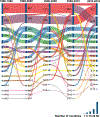The form and evolution of international migration networks, 1990-2015
- PMID: 39091489
- PMCID: PMC11293366
- DOI: 10.1002/psp.2432
The form and evolution of international migration networks, 1990-2015
Abstract
Presently, there is no agreed upon data-driven approach for identifying the geographic boundaries of migration networks that international migration systems are ultimately manifested in. Drawing from research on community detection methods, we introduce and apply the Information Theoretic Community Detection Algorithm for identifying and studying the geographic boundaries of migration networks. Using a new set of estimates of country-to-country migration flows every 5 years from 1990 to 1995 to 2010-2015, we trace the form and evolution of international migration networks over the past 25 years. Consistent with the concept of dynamic stability, we show that the number, size and internal country compositions of international migration networks have been remarkably stable over time; however, we also document many short-term fluctuations. We conclude by reflecting on the spirit of our work in this paper, which is to promote consensus around tools and best practices for identifying and studying international migration networks.
Keywords: community detection; directed networks; international migration; migration flows; migration networks; migration systems.
Conflict of interest statement
CONFLICT OF INTEREST The authors declare no conflict of interest.
Figures








Similar articles
-
Resituating relaunched migration systems as emergent entities manifested in geographic structures.Migr Stud. 2019 Mar;7(1):39-58. doi: 10.1093/migration/mnx066. Epub 2017 Dec 20. Migr Stud. 2019. PMID: 31572608 Free PMC article.
-
Overcoming the Problems of Inconsistent International Migration data: A New Method Applied to Flows in Europe.Eur J Popul. 2010 Nov;26(4):459-481. doi: 10.1007/s10680-010-9220-z. Epub 2010 Oct 28. Eur J Popul. 2010. PMID: 21124647 Free PMC article.
-
Citizen-sensor-networks to confront government decision-makers: Two lessons from the Netherlands.J Environ Manage. 2017 Jul 1;196:234-251. doi: 10.1016/j.jenvman.2017.02.044. Epub 2017 Mar 10. J Environ Manage. 2017. PMID: 28284944
-
The challenge of sustaining effectiveness over time: the case of the global network to stop tuberculosis.Health Policy Plan. 2016 Apr;31 Suppl 1(Suppl 1):i17-32. doi: 10.1093/heapol/czv035. Epub 2015 Aug 17. Health Policy Plan. 2016. PMID: 26282859 Free PMC article.
-
Flows of Substances in Networks and Network Channels: Selected Results and Applications.Entropy (Basel). 2022 Oct 18;24(10):1485. doi: 10.3390/e24101485. Entropy (Basel). 2022. PMID: 37420505 Free PMC article. Review.
Cited by
-
The interplay of migration and cultural similarity between countries: Evidence from Facebook data on food and drink interests.PLoS One. 2022 Feb 9;17(2):e0262947. doi: 10.1371/journal.pone.0262947. eCollection 2022. PLoS One. 2022. PMID: 35139114 Free PMC article.
-
Probabilistic forecasts of international bilateral migration flows.Proc Natl Acad Sci U S A. 2022 Aug 30;119(35):e2203822119. doi: 10.1073/pnas.2203822119. Epub 2022 Aug 22. Proc Natl Acad Sci U S A. 2022. PMID: 35994637 Free PMC article.
-
Uncovering migration systems through spatio-temporal tensor co-clustering.Sci Rep. 2024 Nov 6;14(1):26861. doi: 10.1038/s41598-024-78112-z. Sci Rep. 2024. PMID: 39501001 Free PMC article.
-
Triadic signatures of global human mobility networks.PLoS One. 2024 Feb 23;19(2):e0298876. doi: 10.1371/journal.pone.0298876. eCollection 2024. PLoS One. 2024. PMID: 38394078 Free PMC article.
References
-
- Abel GJ (2013). Estimating global migration flow tables using place of birth data. Demographic Research, 28, 505–546. 10.4054/demres.2013.28.18 - DOI
-
- Abel GJ (2018). Estimates of global bilateral migration flows by gender between 1960 and 2015. International Migration Review, 52(3), 809–852. 10.1111/imre.12327 - DOI
-
- Ali S, & Hartmann D (2015). Migration, incorporation, and change in an interconnected world. Routledge. 10.4324/9781315733036 - DOI
Grants and funding
LinkOut - more resources
Full Text Sources
Miscellaneous
